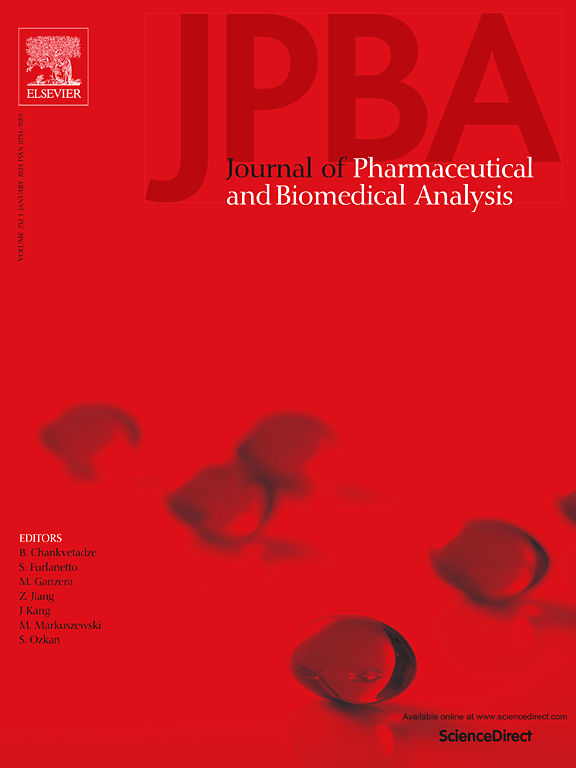基于混合颗粒柱高效液相色谱的螺旋霉素中相关物质的优化分析,以及单心切二维液相色谱-四极杆飞行时间质谱联用仪对其杂质的表征
IF 3.1
3区 医学
Q2 CHEMISTRY, ANALYTICAL
Journal of pharmaceutical and biomedical analysis
Pub Date : 2024-09-24
DOI:10.1016/j.jpba.2024.116486
引用次数: 0
摘要
本文介绍了基于混合颗粒柱的螺旋霉素相关物质分析方法的建立和验证。色谱条件如下:流动相A为水-0.2 mol/L磷酸氢二钾(用1 mol/L KOH溶液调节pH值至9.5)-乙腈-甲醇(10: 60: 28.5: 1.5, v/v/v/v)作为流动相 A,水 - 0.2 mol/L 磷酸氢二钾(pH 值为 9.5) - 乙腈 - 甲醇(10: 30: 57: 3, v/v/v/v)作为流动相 B,进行梯度洗脱。与以往的分析方法相比,该方法特异性强、灵敏度高、稳定性好,可用于螺旋霉素相关物质的日常检测。此外,利用二维液相色谱-四极杆飞行时间质谱(2D LC-QTOF-MS/MS)对0.1%以上的杂质进行了定性,首次报道了6种杂质。本文章由计算机程序翻译,如有差异,请以英文原文为准。
Optimized analysis for related substances in spiramycin based on high performance liquid chromatography with hybrid particle column and characterization of its impurities by single heartcut two-dimensional liquid chromatography coupled with quadrupole time-of-flight mass spectrometer
This article described the development and validation of a method for spiramycin related substances based on hybrid particle column. The chromatographic conditions were as follows: water - 0.2 mol/L dipotassium hydrogen phosphate (the pH value adjusted to 9.5 using a 1 mol/L KOH solution) - acetonitrile - methanol (10: 60: 28.5: 1.5, v/v/v/v) as mobile phase A, water - 0.2 mol/L dipotassium hydrogen phosphate (pH 9.5) - acetonitrile - methanol (10: 30: 57: 3, v/v/v/v) as mobile phase B and gradient elution was performed. Compared with previous analytical methods, this method has strong specificity, excellent sensitivity and stability, which could be used for the daily testing of related substances of spiramycin. Furthermore, impurities above 0.1 % were characterized using two-dimensional liquid chromatography coupled with quadrupole time-of-flight mass spectrometer (2D LC-QTOF-MS/MS) and there were 6 impurities reported for the first time.
求助全文
通过发布文献求助,成功后即可免费获取论文全文。
去求助
来源期刊
CiteScore
6.70
自引率
5.90%
发文量
588
审稿时长
37 days
期刊介绍:
This journal is an international medium directed towards the needs of academic, clinical, government and industrial analysis by publishing original research reports and critical reviews on pharmaceutical and biomedical analysis. It covers the interdisciplinary aspects of analysis in the pharmaceutical, biomedical and clinical sciences, including developments in analytical methodology, instrumentation, computation and interpretation. Submissions on novel applications focusing on drug purity and stability studies, pharmacokinetics, therapeutic monitoring, metabolic profiling; drug-related aspects of analytical biochemistry and forensic toxicology; quality assurance in the pharmaceutical industry are also welcome.
Studies from areas of well established and poorly selective methods, such as UV-VIS spectrophotometry (including derivative and multi-wavelength measurements), basic electroanalytical (potentiometric, polarographic and voltammetric) methods, fluorimetry, flow-injection analysis, etc. are accepted for publication in exceptional cases only, if a unique and substantial advantage over presently known systems is demonstrated. The same applies to the assay of simple drug formulations by any kind of methods and the determination of drugs in biological samples based merely on spiked samples. Drug purity/stability studies should contain information on the structure elucidation of the impurities/degradants.

 求助内容:
求助内容: 应助结果提醒方式:
应助结果提醒方式:


